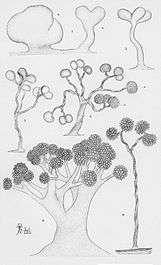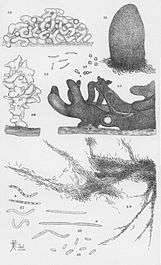Myxobacteria
The myxobacteria ("slime bacteria") are a group of bacteria that predominantly live in the soil and feed on insoluble organic substances. The myxobacteria have very large genomes relative to other bacteria, e.g. 9–10 million nucleotides except for Anaeromyxobacter[1] and Vulgatibacter.[2] One species of myxobacteria, Minicystis rosea,[3] has the largest known bacterial genome with over 16 million nucleotides. The second largest is another myxobacteria Sorangium cellulosum.[4][5] Myxobacteria are included among the delta group of proteobacteria, a large taxon of Gram-negative forms.
| Myxobacteria | |
|---|---|
 | |
| Myxococcus xanthus | |
| Scientific classification | |
| Kingdom: | |
| Phylum: | |
| Class: | |
| Order: | Myxococcales |
Myxobacteria can move by gliding.[6] They typically travel in swarms (also known as wolf packs), containing many cells kept together by intercellular molecular signals. Individuals benefit from aggregation as it allows accumulation of the extracellular enzymes that are used to digest food; this in turn increases feeding efficiency. Myxobacteria produce a number of biomedically and industrially useful chemicals, such as antibiotics, and export those chemicals outside the cell.[7]
Life cycle
When nutrients are scarce, myxobacterial cells aggregate into fruiting bodies (not to be confused with those in fungi), a process long-thought to be mediated by chemotaxis but now considered to be a function of a form of contact-mediated signaling.[8][9] These fruiting bodies can take different shapes and colors, depending on the species. Within the fruiting bodies, cells begin as rod-shaped vegetative cells, and develop into rounded myxospores with thick cell walls. These myxospores, analogous to spores in other organisms, are more likely to survive until nutrients are more plentiful. The fruiting process is thought to benefit myxobacteria by ensuring that cell growth is resumed with a group (swarm) of myxobacteria, rather than as isolated cells. Similar life cycles have developed among certain amoebae, called cellular slime molds.
At a molecular level, initiation of fruiting body development in Myxococcus xanthus is regulated by Pxr sRNA.[10][11]
Myxobacteria such as Myxococcus xanthus and Stigmatella aurantiaca are used as model organisms for the study of development.




Clinical use
Metabolites secreted by Sorangium cellulosum known as epothilones have been noted to have antineoplastic activity. This has led to the development of analogs which mimic its activity. One such analog, known as Ixabepilone is a U.S. Food and Drug Administration approved chemotherapy agent for the treatment of metastatic breast cancer.[12]
Myxobacteria are also known to produce gephyronic acid, an inhibitor of eukaryotic protein synthesis and a potential agent for cancer chemotherapy.[13]
References
- Thomas SH, Wagner RD, Arakaki AK, Skolnick J, Kirby JR, Shimkets LJ, Sanford RA, Löffler FE (May 2008). "The mosaic genome of Anaeromyxobacter dehalogenans strain 2CP-C suggests an aerobic common ancestor to the delta-proteobacteria". PLoS ONE. 3 (5): e2103. doi:10.1371/journal.pone.0002103. PMC 2330069. PMID 18461135.
- "Vulgatibacter incomptus strain DSM 27710, complete genome". 2015-08-19. Cite journal requires
|journal=(help) - "Minicystis rosea strain DSM 24000, complete genome". 2017-01-04. Cite journal requires
|journal=(help) - Schneiker S, Perlova O, Kaiser O, Gerth K, Alici A, Altmeyer MO, et al. (November 2007). "Complete genome sequence of the myxobacterium, Sorangium cellulosum". Nat. Biotechnol. 25 (11): 1281–9. doi:10.1038/nbt1354. PMID 17965706.
- Land M, Hauser L, Jun SR, Nookaew I, Leuze MR, Ahn TH, Karpinets T, Lund O, Kora G, Wassenaar T, Poudel S, Ussery DW (March 2015). "Insights from 20 years of bacterial genome sequencing". Funct. Integr. Genomics. 15 (2): 141–61. doi:10.1007/s10142-015-0433-4. PMC 4361730. PMID 25722247.
- Mauriello EM, Mignot T, Yang Z, Zusman DR (June 2010). "Gliding motility revisited: how do the myxobacteria move without flagella?". Microbiol. Mol. Biol. Rev. 74 (2): 229–49. doi:10.1128/MMBR.00043-09. PMC 2884410. PMID 20508248.
- Reichenbach H (September 2001). "Myxobacteria, producers of novel bioactive substances". J. Ind. Microbiol. Biotechnol. 27 (3): 149–56. doi:10.1038/sj.jim.7000025. PMID 11780785.
- Kiskowski MA, Jiang Y, Alber MS (December 2004). "Role of streams in myxobacteria aggregate formation". Phys Biol. 1 (3–4): 173–83. doi:10.1088/1478-3967/1/3/005. PMID 16204837.
- Sozinova O, Jiang Y, Kaiser D, Alber M (August 2005). "A three-dimensional model of myxobacterial aggregation by contact-mediated interactions". Proc. Natl. Acad. Sci. U.S.A. 102 (32): 11308–12. doi:10.1073/pnas.0504259102. PMC 1183571. PMID 16061806.
- Yu YT, Yuan X, Velicer GJ (May 2010). "Adaptive evolution of an sRNA that controls Myxococcus development". Science. 328 (5981): 993. doi:10.1126/science.1187200. PMC 3027070. PMID 20489016.
- Fiegna F, Yu YT, Kadam SV, Velicer GJ (May 2006). "Evolution of an obligate social cheater to a superior cooperator". Nature. 441 (7091): 310–4. doi:10.1038/nature04677. PMID 16710413.
- "FDA Approval for Ixabepilone". National Cancer Institute.
- Sasse F, Steinmetz H, Höfle G, Reichenbach H (January 1995). "Gephyronic acid, a novel inhibitor of eukaryotic protein synthesis from Archangium gephyra (myxobacteria). Production, isolation, physico-chemical and biological properties, and mechanism of action". J. Antibiot. 48 (1): 21–5. doi:10.7164/antibiotics.48.21. PMID 7868385.